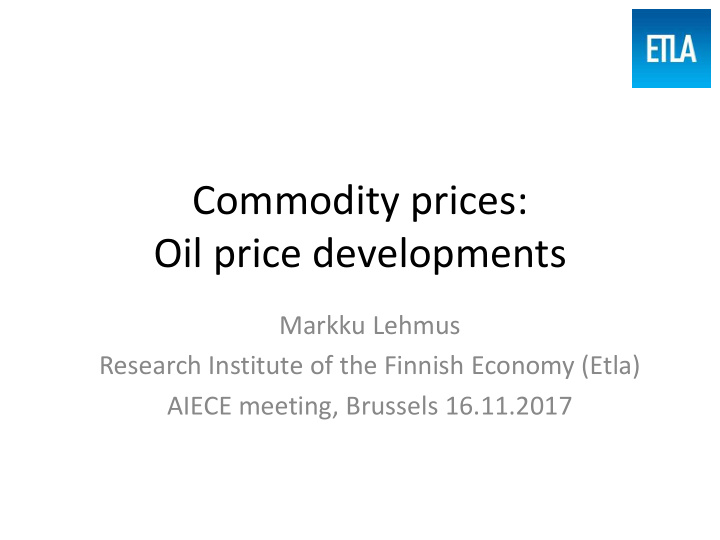



Commodity prices: Oil price developments Markku Lehmus Research Institute of the Finnish Economy (Etla) AIECE meeting, Brussels 16.11.2017
This presentation • Sums up the recent trends in oil (and commodity) prices • Discusses core factors determining price changes: - The OPEC oil production quota set last year - Strong demand, especially from China - The role of the US shale oil production • Some estimations for the supply side dynamics • Future trends in oil prices?
HWWI Index, including and excluding energy 2007 – 2017 (2015=100)
Weighting of Commodities and Commodity Groups in the HWWI Index Index, total (all commodities) • Weights, HWWI-Index 100 HWWI Index, total HWWI Index, total excl. Energy 13.8 Food total 5.7 8.1 Industrial raw materials Energy raw materials 86.2 2.56 - Coal 68.93 - Crude Oil 14.70 - Natural gas
Oil price (Brent) 2016:M01 – 2017M10
An important driver of recent prices changes: The oil production quota agreement • A quota agreement at the November 2016 OPEC conference (announcement already on September 2016) • Deal between OPEC, Russia and nine other nations aims holding back daily oil production by 1.8 million barrels per day (bpd) -> Success, mostly (see FIGURE 3) • Before November 2016, the OPEC daily production was 33,4m barrels per day. On the third quarter this year , the daily average OPEC production has been 32,9m barrels per day - > Nigeria and Libya are outside of the deal and have added their production significantly, which has dulled the impact of the deal • After the OPEC announcement of QUOTAs, the price level has stabilized, and recently even increased (partly due to political unrest in the Middle East)
Figure 3. OPEC Cuts Don’t Meet Target, Allies Do Thousands of barrels a day (source: Bloomberg)
Current demand outpaces supply • Despite some market skepticism, oil markets have been slightly undersupplied this year, resulting in inventory drawdowns. • The biggest drivers alongside the OPEC quota: - Bigger than estimated oil demand from China - Accelerating world economy - And expectations that the OPEC production cuts will be extended through 2018
The US response • All eyes are now on the response from the US shale industry: - Indeed, American drillers have filled some of the supply gap left this year by OPEC and other oil exporters • Recent weekly data shows U.S. crude production at 9.55 million barrels a day, just short of the Sept. 29 high going back to July 10, 2015 • Also US crude exports hit a record high of 2.1m barrels per day last week (FT 2.11.2017)
4-Week Average U.S. Field Production of Crude Oil (Thousand Barrels per Day)
The response of the US shale industry? • Estimation of the response of the US oil rigs to oil price changes
American shale oil production has responded sharply to changes in oil prices ( left axis = oil price, right axis = number of rigs )
Estimating the US oil rigs response to oil prices • We can estimate with the US data (using OLS) LOG(OIL_RIGS t ) = 1.25 + 1.28*LOG(OIL_PRICE t-4 ) Adjusted R2 = 0.95 -> 1 per cent increase in oil price has in 4 months been associated with 1.28 per cent increase in the number of US oil rigs
The supply side dynamics • The US shale oil procuction has proved to adapt quickly to changes in oil prices • Increased US production has lowered price pressures • I also estimate an equation according to which a one percent increase in the US oil production is associated with a 1.6 decrease in oil prices - > Again, proves negative connection between the US oil production and oil prices - > However, R2 now much smaller now, 0.55 • There are other, probably more important factors determining oil prices (the US production only one factor)
Future trends in oil prices • What about oil price development next year and forward?
IEA (12 October 2017) : “Taking 2018 as a whole, oil demand and non-OPEC production will grow by roughly the same volume and it is this current outlook that might act as the ceiling for aspirations of higher oil prices.”
Future trends in oil prices • Underinvestment in new capacity due to recent years’ low price level may increase price pressures during next couple of years • Faster than expected growth of the world economy affects the same direction - > At least as long as China retains its current appetite for oil
The 2020s is different? • The next decade may prove to be very different -> Electric cars, new technologies that would replace oil? • At least these scenarios keep big firms cautious when planning investments in new production capacity
Recommend
More recommend